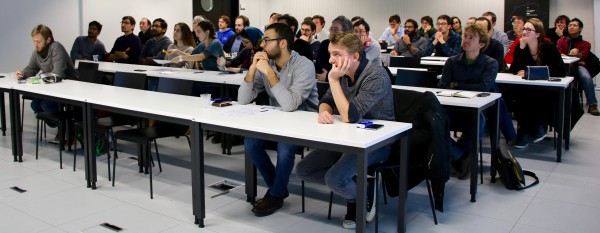MARVEL Junior Seminar — November 2017
The MARVEL Junior Seminars aim to intensify interactions between the MARVEL Junior scientists belonging to different research groups located at EPFL. The EPFL community interested in MARVEL research topics is very welcome to attend. We believe that these events will be central for establishing a vibrant community.
Each seminar consists of two presentations of 25 minutes each, allowing to present on a scientific question in depth, each presentation being followed by 10 minutes for discussion. The discussion is facilitated and timed by the chairperson of the day whose mission is to ensure active lively interactions between the audience and the speakers.
Pizza is served as of 11:45 in the MED hall (floor 0), and after the seminar at 13:30 you are cordially invited for coffee and dessert to continue discussion with the speakers.

MARVEL Junior Seminar Organizing Committee — Ariadni Boziki, Francesco Ambrosio, Davide Campi, Sandip De, Gloria Capano, Michele Pizzochero, Quang Van Nguyen, Kun-Han Lin, Francesco Maresca and Nathalie Jongen
Check the list of the next MARVEL Junior Seminars here.
Abstract — Bridging the gap between atomistic and macroscopic
models of homogeneous nucleation - Bingqing Cheng
Nucleation has many implications in science and technology, including metal casting, the assembly of microtubules in cells, and the formation of water droplets in the atmosphere. Because the experimental investigation of dynamical nucleation processes is very difficult, much attention has been paid to atomistic simulation efforts in the last two decades.
However, atomistic simulation studies of nucleation face two major challenges. Firstly, the free energy barrier separating the metastable phase and the stable phase can be very high, making nucleation times much larger than the time scales accessible to molecular dynamics simulations. Secondly, it is highly non-trivial to develop a predictive macroscopic model of nucleation using the microscopic quantities directly obtained from atomistic simulations.
In this seminar, I aim to address the aforementioned difficulties. I will first briefly introduce state-of-the-art enhanced sampling methods for atomistic simulations, and their applications to studying homogeneous nucleation. I will then discuss our latest thermodynamic model that links macroscopic theories and atomic-scale simulations and thus provide a simple and elegant framework to verify and extend classical nucleation theory.
References:
1. Laio, A., & Parrinello, M. (2002), Escaping free-energy minima, Proceedings of the National Academy of Sciences, 99(20), 12562-12566.
2. Cheng, B., Tribello, G. A., & Ceriotti, M. (2015), Solid-liquid interfacial free energy out of equilibrium, Physical Review B, 92(18), 180102.
3. Cheng, B., & Ceriotti, M. (2017), Bridging the gap between atomistic and macroscopic models of homogeneous nucleation, The Journal of chemical physics, 146(3), 034106.
4. Cheng, B., Tribello, G. A., & Ceriotti, M. (2017), The Gibbs free energy of homogeneous nucleation: from atomistic nuclei to the planar limit, The Journal of chemical physics, 147(10), 104707.
Abstract — Computational screening of useful hole-electron dopants in SnO2 - Jose A. Flores-Livas
Doped tin-dioxide (SnO2) is an important semiconductor that is already used in diverse applications. However, in order to uncover the entire potential of this material in more advanced applications of optoelectronics further improvements in electrical properties are necessary. In this work we perform an extensive search for useful substitutional dopants of SnO2. We propose the use of a well-converged protocol to scan the entire the whole periodic table for dopants finding excellent agreement between our predictions and those substitutional dopants that have been experimentally examined to date. The results of this large-scale dopant study allows us to better understand the doping trends in this important TCO material.
Low-volume newsletters, targeted to the scientific and industrial communities.
Subscribe to our newsletter